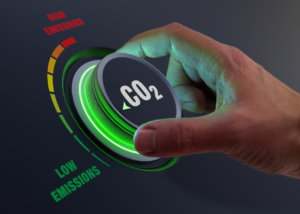State officials are studying revised climate plans that would require 50% cuts in carbon emissions from commercial buildings by 2030 and levy a $100 per ton carbon emissions fee on properties that fail to achieve that reduction.
On Sept. 18, the Maryland Department of Environment released a revised draft pathway to decarbonize commercial and residential buildings. The revisions include an accelerated timeline that would require 50% of commercial buildings be decarbonized by 2030 and all buildings reach net zero emissions by 2040.
 The speed and scale of the recommended conversion of the state’s building stock are unprecedented. Massachusetts and New York are implementing similar energy transition policies but are targeting a 2050 completion date to allow time for natural turnover of building systems and technology improvements.
The speed and scale of the recommended conversion of the state’s building stock are unprecedented. Massachusetts and New York are implementing similar energy transition policies but are targeting a 2050 completion date to allow time for natural turnover of building systems and technology improvements.
More than 1.7 million commercial buildings in the state are served by natural gas, oil and propane heating equipment. Climate consultants to New Jersey, New York, Massachusetts and Maryland have advised that low and zero carbon fuels will be a critical part of cost-effective emissions reductions from buildings.
MDE and the Climate Commission’s Mitigation Working Group have been considering a clean heat standard that would incrementally reduce the carbon intensity of gas and delivered fuels until reaching net zero in 2045. A recent state study found that electrification of heating equipment with fuel backup had the lowest consumer cost and required less expansion of electric generating and distribution capacity of three scenarios evaluated.
In recent days, opposition to the continued use of gas infrastructure and uncertainties about the cost and availability of synthetic natural gas, green hydrogen and biofuels have prompted MDE to study an alternative scenario that replaces the clean fuels standard with a $100 per ton carbon emissions non-compliance fee. Conceptually, this carbon tax would apply to onsite emissions above a certain threshold that would gradually reduce over time until reaching a net-zero. Proceeds would be used to purchase carbon reductions at lower cost, which could include retrofitting better situated buildings, forest restoration or, in the future, perhaps paying for mechanical carbon sequestration through technologies known as direct air capture.
Maryland participates in the Regional Greenhouse Gas Initiative (RGGI) which is a carbon trading market for utility emissions. Carbon emissions from electric power generation are capped and utilities purchase emissions allowances at sealed bid price auctions. Proceeds are distributed to the participating states to fund energy efficiency and climate mitigation strategies.
Both the Governor and General Assembly leadership have expressed preliminary interest in the Transportation Climate Initiative, a similar quasi-market-based approach which would impose a cap on automobile emissions and require fuel producers to buy emissions allowances on a regional exchange. The proceeds would be directed toward speeding consumer adoption of electric and zero emissions vehicles.
Both the Hogan Administration and leaders in the General Assembly have endorsed reaching economy-wide net zero emissions by 2045. Policies to transform how utilities generate power and accelerate the transition to electric automobiles have been set in motion. Direct energy use in buildings generates 13% of state-wide carbon emissions and the goals set by the General Assembly cannot be met without eliminating emissions from buildings by mid-century. Legislators are expected to debate legislation to implement a pathway to decarbonize buildings when the General Assembly reconvenes in January.